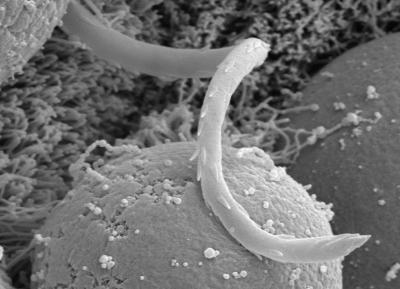Lethal parasite evolved from pond scum

The corkscrew-shaped Helicosporidium is a parasite that has its origins in green alga. Credit: Photo: Drion Boucias, University of Florida
A team led by UBC Botany Prof. Patrick Keeling sequenced the genome of Helicosporidium – an intracellular parasite that can kill juvenile blackflies, caterpillars, beetles and mosquitoes – and found it evolved from algae like another notorious pathogen: malaria.
Keeling and colleagues had previously reported that malaria shared a common evolutionary lineage with the algae responsible for toxic red tides. Their latest study, published today in the online journal PLOS Genetics, shows that Helicosporidium evolved from green alga but, unlike malaria, preserved virtually all its genes except those required for photosynthesis.
“Both malaria and Helicosporidium started out as alga and ended up as intracellular parasites preying on animals, but they have done it in very different ways,” says Keeling, director of the Centre for Microbial Diversity and Evolution at UBC and a Senior Fellow of Canadian Institute for Advanced Research.
“Malaria drastically reduced its genome and became very dependent on its host for nutrients. Helicosporidium, on the other hand, lost almost nothing except those genes required for photosynthesis, which it no longer needs as a parasite.
“It's as if photosynthesis has been surgically removed from its genome.”
The discovery, done in collaboration with scientists at the Universities of Rhode Island and Florida, will allow researchers to compare how parasites evolve at the molecular level in these two distantly related lineages.
It also provides the first insights into their origins, development as well as methods of infection, which are key to controlling the population of pest-insect hosts.
Media Contact
More Information:
http://www.ubc.caAll latest news from the category: Life Sciences and Chemistry
Articles and reports from the Life Sciences and chemistry area deal with applied and basic research into modern biology, chemistry and human medicine.
Valuable information can be found on a range of life sciences fields including bacteriology, biochemistry, bionics, bioinformatics, biophysics, biotechnology, genetics, geobotany, human biology, marine biology, microbiology, molecular biology, cellular biology, zoology, bioinorganic chemistry, microchemistry and environmental chemistry.
Newest articles

Trotting robots reveal emergence of animal gait transitions
A four-legged robot trained with machine learning by EPFL researchers has learned to avoid falls by spontaneously switching between walking, trotting, and pronking – a milestone for roboticists as well…

Innovation promises to prevent power pole-top fires
Engineers in Australia have found a new way to make power-pole insulators resistant to fire and electrical sparking, promising to prevent dangerous pole-top fires and reduce blackouts. Pole-top fires pose…

Possible alternative to antibiotics produced by bacteria
Antibacterial substance from staphylococci discovered with new mechanism of action against natural competitors. Many bacteria produce substances to gain an advantage over competitors in their highly competitive natural environment. Researchers…





















